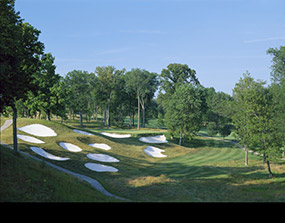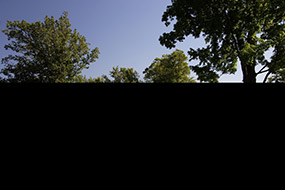One of the most relentless tests of golf in the Midwest, Wolf Run is situated 20 miles north of Indianapolis and was founded by a local dentist wanting to build a demanding golf-only club for accomplished players. His selected site for the course was a partly forested tract of land blessed with both a large ridge and the aptly named Eagle Creek cutting through the property.
Designed by a relatively unheralded architect, the course opened in 1989 and immediately raised eyebrows, both for its difficulty and the quality of Steve Smyers’ design. Routing much of his front nine across an open cornfield, Smyers set the back nine partly within a wooded bluff with the creek popping up regularly throughout the round to add strategic and visual interest. His main method of protecting par was to build narrow fairways surrounded by punishing native fescues and to create small, contoured greens. The bunkering is also quite striking. Rugged and generally deep, the traps are positioned to punish those who stray, but hitting away from sand leaves tricky recovery shots as short grass and steep slopes create a great variety of short game challenges.
The sense that Wolf Run is pretty special hits from the moment you step onto the 1st tee, the hole played from atop a large hill down onto a valley fairway defined by waving fescue grasses and a series of wonderful bunkers arranged diagonally along the left side. A tee shot played safely to the right leaves an awkward approach angled across further traps and into the shallow part of a small target. The 2nd hole is a long par three played to a green placed directly over the creek. This same creek wraps around the side of the miniscule drop-kick 16th green and cuts across the 15th and 7th fairways, the approach on the 7th played from an upper shelf to another tiny target beside the water.
Away from the hazard, memorable holes include the par four 9th, which turns left from a crowned fairway and rises into a tiered green surrounded by pot bunkers, and the brutal stretch from the 12th to the 15th. Visually intimidating from the tee, the 13th is a cracking par three played from an abrupt ledge out across a deep valley and into a green resting perilously beyond a heavily bunkered hillside. The 14th is just as nasty, with the drive bending around a small mound and the falling approach an all-carry shot across water to an undulating green with plenty of sand trouble. The narrow drive and elevated green site on the 15th are also seriously challenging, as is the final approach shot into the 18th, played with a mid-iron across a deep ravine.
The strength of Wolf Run is the consistent quality of its holes and Smyers’ stylish bunkering and creative green complexes, which, although small, effectively test both approach play and the golfers powers of recovery. The layout is perhaps a little too severe on players with mid-to-high handicaps, but given the degree of difficulty it is surprising that major magazine’s have overlooked this fine course in their ranking lists.

 this course also has exceptional:
this course also has exceptional:

